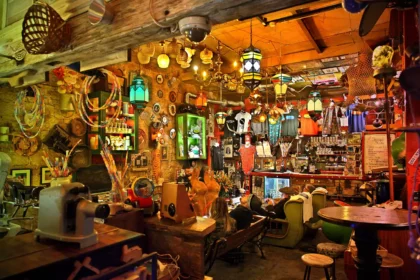

CONTACT US
1052 Budapest, Jane Haining Quay, Dock 11.
Customer support is available daily from 9:00 to 22:00.

Nestled in the enchanting city of Budapest lies an urban oasis that has captured the hearts of locals and tourists alike – the renowned “ruin bars.” These unique and vibrant establishments have become an integral part of Budapest’s nightlife, offering a glimpse into the city’s rich history, creative spirit, and relentless pursuit of reinvention. In this article, we delve into the captivating world of ruin bars, exploring their origins, their role in urban revitalization, and the authentic experiences they provide to all who visit.
The story of ruin bars begins in the early 2000s when a group of visionary entrepreneurs spotted an opportunity within Budapest’s decaying, abandoned buildings. The city was dotted with numerous neglected structures, the remnants of World War II and the 1956 Hungarian Revolution. Rather than demolishing these neglected buildings, these enterprising minds sought to breathe new life into them by transforming them into vibrant social spaces. And so, the concept of “ruin bars” was born.
What sets ruin bars apart is their distinctive blend of urban decay, quirky design, and bohemian atmosphere. Walking through the streets of Budapest’s Jewish Quarter, visitors stumble upon nondescript entrances leading to hidden gems behind dilapidated facades. As they step inside, they are greeted by a mesmerizing fusion of eclectic decor – mismatched furniture, vintage objects, colorful graffiti, and an array of art installations.
Each ruin bar has its own character, as artists and designers continuously reimagine the spaces, resulting in an ever-changing landscape of creativity. Some bars maintain a raw and rough-around-the-edges ambiance, while others embrace a more polished and artistic vibe. This dynamic architecture captivates patrons, encouraging them to explore every nook and cranny, never knowing what delightful surprise they might encounter around the corner.
Beyond their aesthetic appeal, ruin bars have emerged as vital community and cultural hubs. They provide an inclusive space for locals and tourists to mingle, fostering an atmosphere of camaraderie and openness. Visitors can strike up conversations with people from diverse backgrounds, fostering a global exchange of ideas and experiences.
Throughout the week, these bars host a range of events, from live music performances and art exhibitions to film screenings and language exchange meetups. The cultural diversity of Budapest is reflected in the eclectic programs, making the ruin bars a melting pot of creativity and intellectual stimulation.
Ruin bars offer a poignant reminder of Budapest’s past, serving as a living testament to the city’s resilience and capacity for reinvention. Many of these buildings were once abandoned factories, warehouses, or tenement houses, and by transforming them into lively bars, the city has breathed new life into its historical structures.
Amid the buzz of contemporary nightlife, visitors can still witness remnants of the past, like old machinery or fading posters on the walls. This seamless blend of history and modernity creates a sense of nostalgia and evokes a curiosity about the stories these buildings could tell if their walls could speak.
One cannot truly understand the allure of ruin bars until experiencing them firsthand. As the sun sets and the lights start to flicker, the atmosphere transforms. Locals and tourists alike gather to enjoy a diverse range of beverages, from local Hungarian wines to craft beers and innovative cocktails. The vibrant chatter and laughter fill the air, creating a warm and inviting ambiance that envelops everyone in its embrace.
One popular ruin bar, Szimpla Kert, is often considered the pioneer of the ruin bar movement. Founded in 2002, it has become an iconic establishment in Budapest. From the open-air courtyard to the labyrinthine interiors, Szimpla Kert never fails to impress visitors with its immersive and sensory experience.
The rise of ruin bars in Budapest has had a transformative impact on the city’s urban landscape. As these abandoned buildings found new life, surrounding neighborhoods experienced a wave of revitalization. The influx of visitors generated economic growth, leading to the emergence of new businesses, including art galleries, cafes, and independent boutiques.
Moreover, the success of ruin bars has inspired similar ventures in other cities worldwide. The concept of repurposing abandoned spaces as cultural hubs has proven to be an effective means of revitalizing neglected urban areas, fostering a sense of community, and promoting local arts and culture.
The phenomenon of Budapest’s ruin bars is a testament to the power of creativity and innovation in breathing life into forgotten spaces. These establishments have not only transformed abandoned buildings but have also revitalized entire neighborhoods, making Budapest a vibrant and dynamic city that continues to evolve.
The allure of ruin bars lies in their ability to blend history, community, and culture into a seamless and immersive experience. From their unique architecture to their role as cultural melting pots, ruin bars have become an integral part of Budapest’s identity, inviting visitors to embrace the city’s past and present with open arms. So, the next time you find yourself in Budapest, don’t miss the opportunity to explore the enigmatic world of ruin bars – a journey that promises memories of a lifetime.